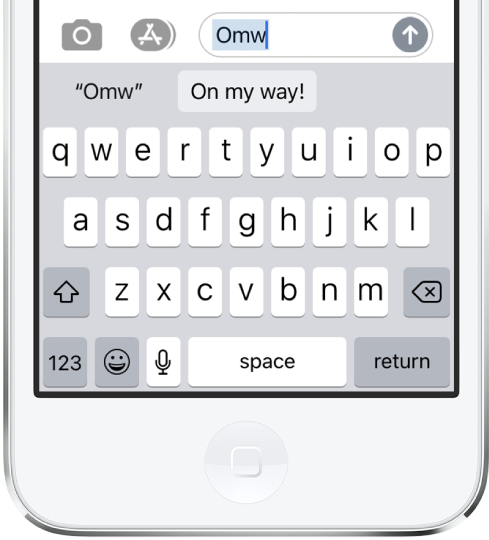iPod touch User Guide
- Welcome
- Your iPod touch
- What’s new in iOS 14
-
- Wake and unlock
- Learn basic gestures
- Adjust the volume
- Change or turn off the sounds
- Access features from the Lock Screen
- Open apps
- Take a screenshot or screen recording
- Change or lock the screen orientation
- Change the wallpaper
- Search with iPod touch
- Use AirDrop to send items
- Perform quick actions
- Use and customize Control Center
- Add widgets
- Charge and monitor the battery
- Learn the meaning of the status icons
- Travel with iPod touch
-
- Calculator
-
- View maps
-
- Use Siri, Maps, and widgets to get directions
- Choose your preferred type of travel
- Get driving directions
- Report traffic incidents
- Get cycling directions
- Get walking directions
- Get transit directions
- Change audio settings for turn-by-turn directions
- Select other route options
- Get directions between places other than your current location
- Delete recently viewed directions
- Use Maps on your Mac to get directions
- Help correct and improve Maps
- Get rides
-
- View photos and videos
- Delete and hide photos and videos
- Edit photos and videos
- Edit Live Photos
- Organize photos in albums
- Search in Photos
- Share photos and videos
- View Memories
- Find people in Photos
- Browse photos by location
- Use iCloud Photos
- Share photos with iCloud Shared Albums
- Use My Photo Stream
- Import photos and videos
- Print photos
- Shortcuts
- Stocks
- Tips
- Weather
-
- Accessories for charging iPod touch
-
- Set up AirPods
- Charge AirPods
- Start and stop audio playback
- Change the AirPods volume
- Make and answer calls with AirPods
- Switch AirPods between devices
- Use Siri with AirPods
- Listen and respond to messages
- Share audio with AirPods and Beats headphones
- Change noise control modes
- Restart AirPods
- Change the name of your AirPods and other settings
- Use other Bluetooth headphones
- Use EarPods
- Check headphone sound levels
- HomePod and other wireless speakers
- External storage devices
- Magic Keyboard
- Printers
-
- Get started with accessibility features
-
-
- Turn on and practice VoiceOver
- Change your VoiceOver settings
- Learn VoiceOver gestures
- Operate iPod touch using VoiceOver gestures
- Control VoiceOver using the rotor
- Use the onscreen keyboard
- Write with your finger
- Use VoiceOver with an Apple external keyboard
- Use a braille display
- Type onscreen braille
- Customize gestures and keyboard shortcuts
- Use VoiceOver with a pointer device
- Use VoiceOver in apps
- Zoom
- Magnifier
- Display & Text Size
- Motion
- Spoken Content
- Audio Descriptions
-
- Copyright
Save keystrokes with text replacements on iPod touch
Set up a text replacement you can use to enter a word or phrase by typing just a few characters. For example, type “omw” to enter “On my way!” That one’s already set up for you, but you can also add your own.

Create a text replacement
While typing in a text field, touch and hold
 or
or  .
.Tap Keyboard Settings, then tap Text Replacement.
Tap
 at the top right.
at the top right.Type a phrase in the Phrase field and the text shortcut you want to use for it in the Shortcut field.
Have a word or phrase you use and don’t want it corrected?
Go to Settings
 > General > Keyboard, then tap Text Replacement.
> General > Keyboard, then tap Text Replacement.Tap
 at the top right, then enter your word or phrase in the Phrase field, but leave the Shortcut field blank.
at the top right, then enter your word or phrase in the Phrase field, but leave the Shortcut field blank.
Create a text replacement for word and input pairs
When using certain Chinese or Japanese keyboards, you can create a text replacement for word and input pairs. The text replacement is added to your personal dictionary. When you type the text shortcut for a word or input while using a supported keyboard, the paired word or input is substituted for the typed shortcut.
Shortcuts are available for the following:
Simplified Chinese: Pinyin
Traditional Chinese: Pinyin and Zhuyin
Japanese: Romaji and Kana
Use iCloud to keep your personal dictionary up to date on your other devices
Go to Settings ![]() > [your name] > iCloud, then turn on iCloud Drive.
> [your name] > iCloud, then turn on iCloud Drive.
Reset your personal dictionary
Go to Settings
 > General > Reset.
> General > Reset.Tap Reset Keyboard Dictionary.
All custom words and shortcuts are deleted, and the keyboard dictionary returns to its default state.
